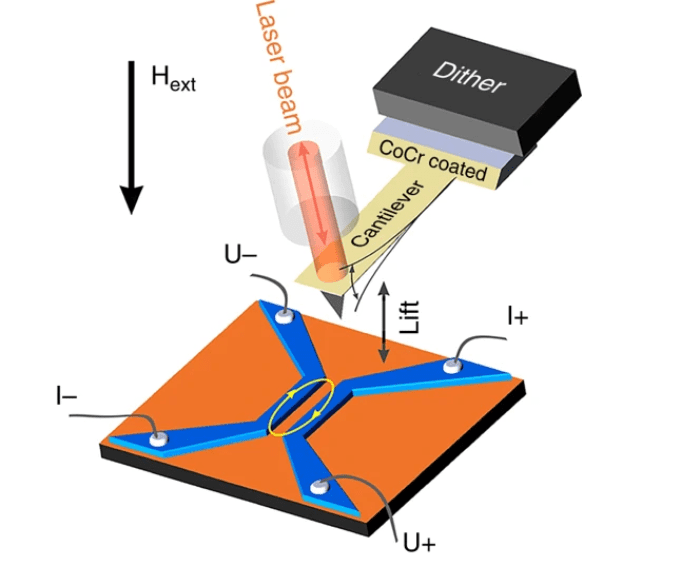Nov 4 2019
Physicists from MIPT have found a way to achieve local control of Josephson vortices. The finding can be applied for next-generation quantum processors and quantum electronics superconducting devices. The study has been reported in Nature Communications, a renowned scientific journal.
 Quantum Computers" />Experimental setup. The blue and orange indicate niobium and copper, respectively. The ellipse marks the area of the Josephson junction. The cobalt-chromium-coated tip oscillates, excited by a piezo element (dither). The optic fiber is used to read out the oscillations. (Image credit: Viacheslav Dremov et al./Nature Communications)
Quantum Computers" />Experimental setup. The blue and orange indicate niobium and copper, respectively. The ellipse marks the area of the Josephson junction. The cobalt-chromium-coated tip oscillates, excited by a piezo element (dither). The optic fiber is used to read out the oscillations. (Image credit: Viacheslav Dremov et al./Nature Communications)
A Josephson vortex is a vortex of currents present in a system of two superconductors isolated by a weak link (for example, a normal metal, a dielectric, etc.), under the influence of an external magnetic field. It was in 1962 that Brian Josephson proposed the flow of a supercurrent via a thin layer of insulating material that isolates two pieces of superconducting material.
Named after him, this current was called the Josephson current, and the coupling of superconductors was termed a Josephson junction. A so-called weak link exists between the two superconductors via a nonsuperconducting or dielectric metal, forming macroscopic quantum coherence.
Upon placing this system in a magnetic field, the field is pushed out by the superconductors. The value of the applied magnetic field is directly proportional to the superconductivity resisting the magnetic field that penetrates into the Josephson system.
The weak link is, however, a spot at which the field can get through in the form of independent Josephson vortices that carry magnetic flux quanta. In general, Josephson vortices are regarded as real topological objects—2 pi-phase singularities that are challenging to see and control.
Scientists at the MIPT Laboratory of Topological Quantum Phenomena in Superconducting Systems employed a magnetic force microscope to analyze Josephson vortices in a system consisting of two superconducting niobium contacts interleaved with a copper layer that serves as a weak link.
We have demonstrated that in the planar (flat) superconductor-normal metal-superconductor contacts, Josephson vortices have a unique imprint. We found this by observing these structures with a magnetic force microscope. Based on this discovery, we demonstrated the possibility of locally generating Josephson vortices, which can be manipulated by the magnetic cantilever of a microscope.
Vasily Stolyarov, Study Senior Author, MIPT
Stolyarov continued, “Our research is yet another step toward creating future superconducting quantum computing machines.”
There has been rapid growth with respect to the range of ultrasensitive superconducting devices, architectures, and qubits for quantum computing. Superconducting quantum electronic devices are expected to compete with traditional semiconductor devices very soon. These new devices will be based on Josephson junctions.
It is quite difficult to visualize Josephson vortices, as they are poorly localized. We discovered a way to measure the dissipation that occurs during the creation and destruction of such a vortex in the weak link area. Dissipation is a minor release of energy. In our case, the energy is released when a vortex moves in a planar Josephson contact.
Vasily Stolyarov, Study Senior Author, MIPT
Stolyarov added, “Thus, using our magnetic force microscope, we can successfully detect not only the static magnetic portrait of the superconducting structure but also the dynamic processes in it.”
The researchers exhibited a technique for remotely generating, detecting, and manipulating Josephson vortices in planar Josephson junctions with the help of a low-temperature magnetic force microscope. They used specific parameters (temperature, probe location, electric current flow through the sample, external magnetic field) to observe a specific response of the microscope cantilever.
Subsequently, sharp rings/arcs appeared in the images. According to the team, these features are bifurcation points between adjacent Josephson states, with a different position or number of Josephson vortices within the junction.
During the process, energy is exchanged between the sample and the cantilever at the bifurcation points, showing that a magnetic force microscope has the ability to offer unique information related to the state of a Josephson vortex.
The study outcomes are expected to be useful as a drive and a basis for devising innovative techniques of local noncontact diagnostics and management of advanced superconducting quantum electronics and superconducting devices.
The Russian Science Foundation and the Ministry of Education and Science of the Russian Federation supported the research.